Scandals of Classic Hollywood: In Like Errol Flynn
by Anne Helen Petersen
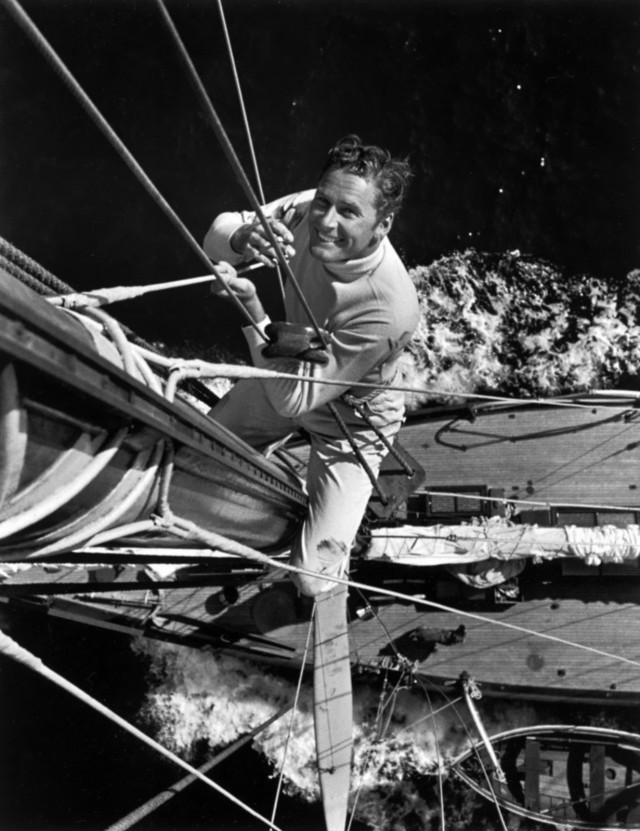
Errol Flynn was that guy — that one guy, we all know them — who was too handsome for his own good. Early on, he figured out what his looks could do for him, and he rode that wave to various destinations. He was a textbook womanizer, an astoundingly successful player — a lech, a cad, a rake, and any number of other British-sounding adjectives that describe the combination of sexual appetite and the charisma required to feed it. When I look at him, I’m simultaneously repulsed and seduced: I know exactly the kind of guy he is, the compliments he’d offer, how he’d make every girl feel unique. What a skeezy, totally hot bastard.
Onscreen, he played a slightly different part — somewhat shy, or just unaware of what the female lead thought of him. His characters were never hardbodies, at least not in the traditional American sense of the word; rather, he spent his time jumping from mast to mast or engaged in elegant swordfighting. Flynn was the most refined sort of hero, with a litheness that could have been framed as feminine if it weren’t for his past in boxing, sailing, and all manner of sports.
It was this combination of on- and off-screen image, of confident womanizer and selfless hero, that truly beguiled. He wasn’t bad the way Jimmy Cagney was bad or Bogart was bad. It was all, it seemed, just a bit of harmless fun. Until it wasn’t anymore, and Flynn was charged with two counts of statutory rape. After a long, highly publicized trial, he was acquitted, but the details remain murky, and Flynn spiraled into deep alcoholism and depression. Today the sordid details of his later life are elided in favor of his jubilant youth, when he was the man in tights of every woman’s dreams.
Flynn’s parents were from Tasmania — that little island south of Australia — and both had long convict family histories, which was the case with many Tasmanians at the time. Yet he grew up relatively wealthy, as his father had made good and become a biology professor, and his mother came from a family of “seafarers,” which led to Flynn’s lifelong interest in boats, the sea, looking natty in white pants, etc. But he was a hell-raiser, expelled a billion times for all sorts of mischief, including purportedly sleeping with a laundress at one of his schools. At 20, he moved to New Guinea, just like a protagonist in a British colonial novel, where he tried to start a tobacco plantation, failed miserably, and failed yet again at a copper mining scheme. Poor little rich Flynn. Then he moved to England, found some rep work, and appeared in a British Warner Bros. production, which prompted the British production manager to write the best telegram to be written about anyone, ever:
“BEST PICTURE WE HAVE EVER SEEN. HE TWENTY-FIVE IRISH LOOKS CROSS BETWEEN CHARLES FARRELL AND GEORGE BRENT SAME TYPE AND BUILD EXCELLENT ACTOR CHAMPION BOXER SWIMMER GUARANTEE HE REAL FIND”
It was, apparently, a done deal. Flynn moved to Hollywood, set up shop as a contract player, and let the seduction begin.
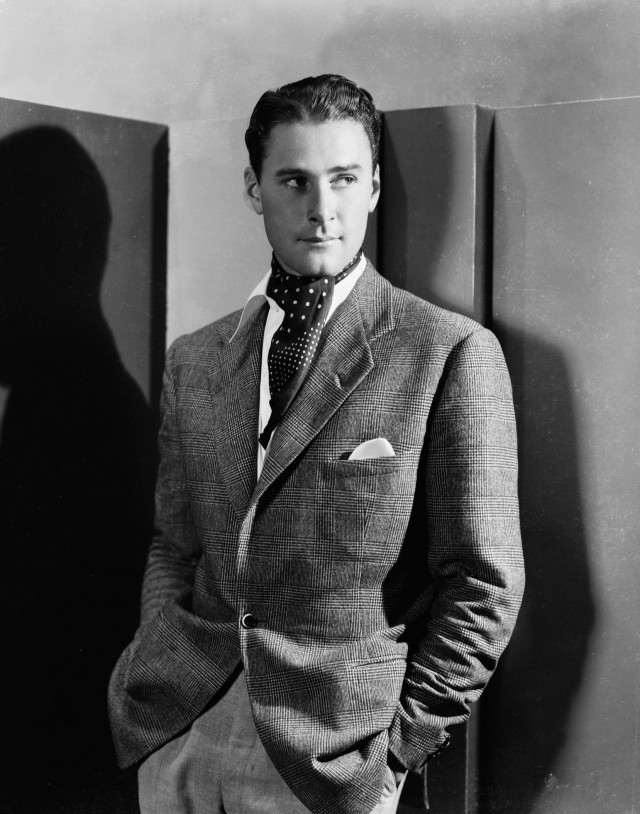
A very young, pre-moustache Flynn.
It was the mid-’30s. The nation was still mired in The Depression, and all the studios (except MGM) were mired in it as well. When Warner Bros. heard that MGM was producing an adaptation of Mutiny on the Bounty with prize star Clark Gable, they decided to counter. The historical seafaring/swordfighting genre was on the rise — Treasure Island and The Count of Monte Cristo had both been big hits in 1934 — but Warner’s didn’t really have the swashbuckling, handsome, Gable-esque stock it needed for Captain Blood. It was the studio of grimy, urban gangster films: think more Cagney, much less Gable. So the studio mined its newly signed talent and came up with this Australian unknown who, after signing his contract and coming stateside, had been relegated to a B-pictures and bit parts.
Captain Blood effectively set Flynn’s type: from that point forward, he would be daring, hot with-and-without a moustache/Prince Valiant hair, and alternately pissing off and seducing his heroine. On sea, in the past, in the desert, in a Western — different setting, same story, always successful. And Warners knew how to make a backstory: they glossed over, for the time being, his Australian background, instead focusing on his Irish heritage, natural athleticism, and outdoorsmanship — a perfect complement to his Captain Blood persona. (With time, the Australian/South Pacific “gap year” time would reemerge — but only when handy. Just you wait.)
Warner Bros. also paired Flynn with Olivia de Havilland, a rising starlet who had distinguished herself as Hermia in A Midsummer Night’s Dream by out-acting all of her male co-stars. De Havilland was mannered, stubborn, and quite British, and she and Flynn were the perfect opposites-attract pairing. As with many classic cinematic couplings, he blunted her harsh angles, and she brought out his softness. They complemented and completed each other — which is part of why neither would be as successful on his/her own as they were together. (You could make an argument for De Havilland doing her best work in Gone with the Wind here, but I won’t be the one to do it.)

De Havilland winning most innovative bathing suit award.
The plot of Captain Blood is classic swashbuckler, focused on “rough, noisy, and boastful swordsmen,” a.k.a. all of my boyfriends ever. I could regale you with plot specifics, but it’d be about as useful as describing the plot to Pirates of the Caribbean 3, starring the poor man’s Errol Flynn himself, Orlando Bloom. Suffice to say: white pirates win, white pirates also get white heroine. Plumes abound, as do leather jodhpurs, generally paired with a flowing white poet’s shirt and a massive leather belt of some sort. Also: swords, backflips, three-cornered hats. I can’t recommend it highly enough.
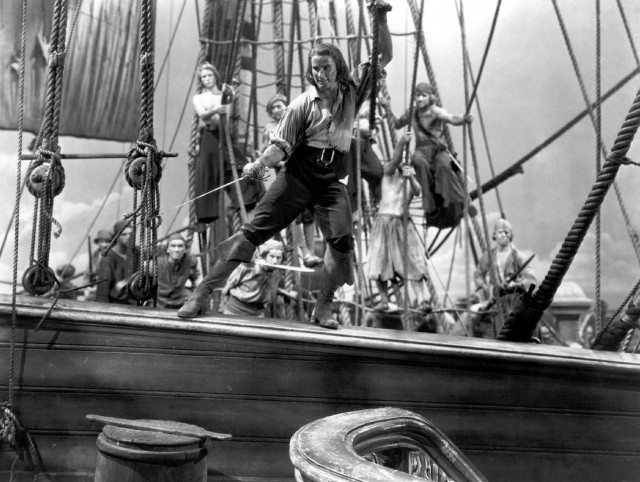
Suddenly, Flynn was an enormous, phenomenal, overnight star — the sort of star the studios dream of: one they sign on a whim, put in a genre picture with another unknown, the chemistry crackles, the plot zings, and, suddenly, studio execs have a formula that will last for half a dozen pictures.
The only downside was that Flynn was already married, which made the ready-made rumors of an on-set romance with Olivia de Havilland impossible. Flynn had met his wife, starlet Lili Damita, before he made the big time. They were just two beautiful maybe-stars who probably wanted to have sex without hiding in closets. And boy oh boy, were they just adorable:
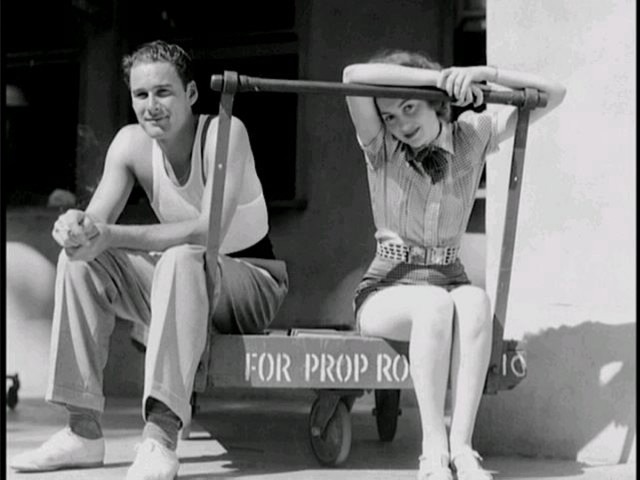
Will you look at those cuffed trousers? But seriously, it just gets better:

Forget the fact that he was soon cheating on her at every turn, and just drink in that cabled sweater.
Over the next six years, Flynn appeared with De Havilland in eight films, all in the same vein, only sometimes the swashbuckling took place on land, with guns, and in cowboy hats. The most important of which, obviously, was The Adventures of Robin Hood (1938).
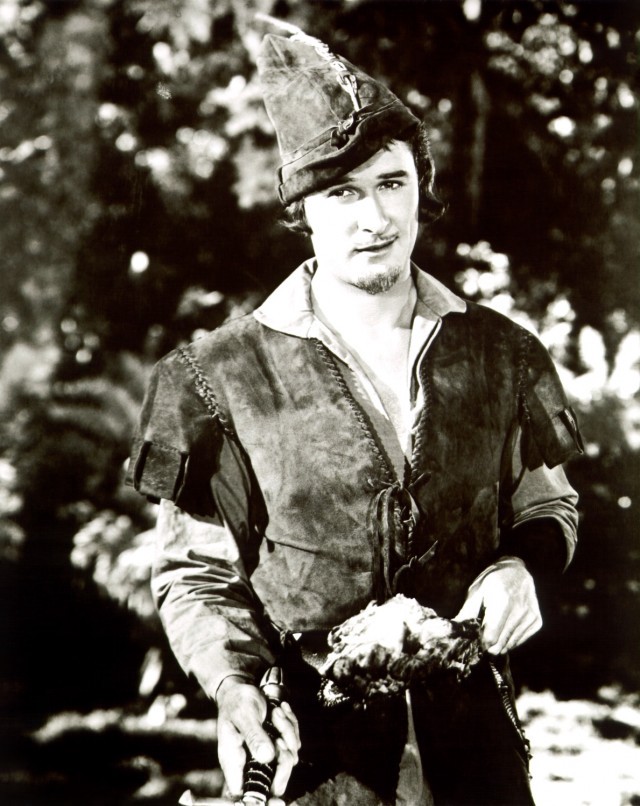
I mean, Kevin Costner, eat your heart out: That is the jauntiest of all jaunty Robin Hood grins. The velvet, the goatee, everything, I love. If Bryan Adams and I were both alive in 1938, I would’ve learned his theme song on the piano and played it for all of my fifth grade friends like a pro.
The shoulder-elk. I mean, really.
Warner Bros. spent a relative ton on the film — especially since it was known for skimping on budgets — even filming it in color. And it was a huge smash: the second highest grosser of the year, and enough to prompt penny-pinching Warner Bros. to cast him in two more Technicolor epics, both, naturally, with Olivia de Havilland. In other words, boy was big news. He had a beautiful wife. He rode in speed boats and looked adorable with a dog. He was Warner Bros. answer to MGM’s Gable, and he looked better with a popped collar. He fooled around but not disastrously so — nothing that the Warner Bros. publicity department couldn’t handle.
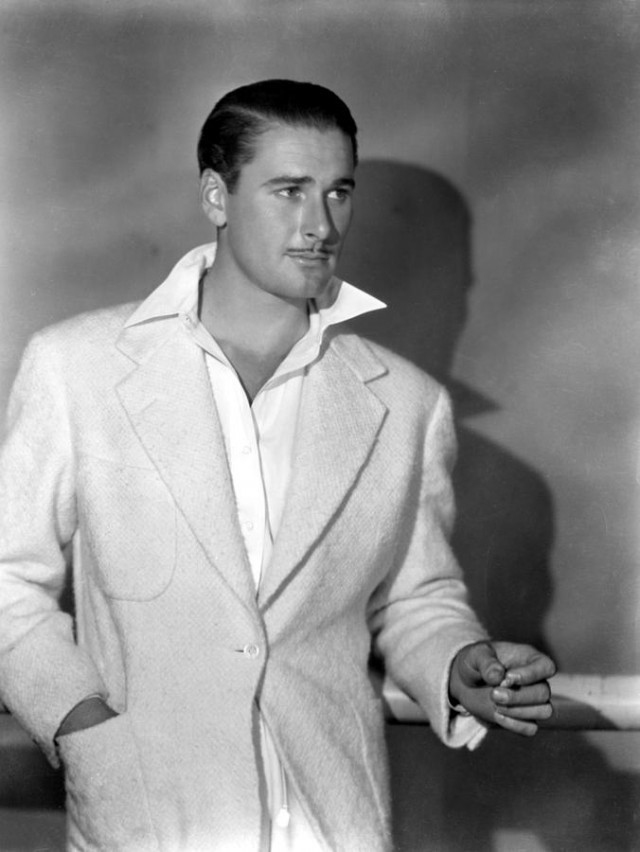
See, for example, the exquisitely rendered “Hollywood Morals” column in Photoplay, purportedly penned by Flynn himself. He begins by setting up “Old Hollywood” as a time of wantonness and loose morals: “In those days men could pick fights and their women were glad to pick them up afterwards. Not only that, but I understand that they even had sex out here in the old days — great gobs of it — and, in their own naive way, they thought it was all pretty swell — grand climate, buxom wenches, two-fisted men and an easy living.” (I can’t even with the two-fisted men, but maybe you can.)
But Flynn:
…wouldn’t know anything about that. It was all long before my day in Hollywood and I resent it just a little. By the time I had arrived, full of the legends of high jinks in Movieland, the Missionaries had moved in and told Hollywood it was all wrong. Mr. Hays called the girls in and begged them to — please, for heaven’s sake — to forget about this sex business for a while.
And then it gets all weird and racially primitive:
While all that was going on out here, I was rambling through the Island among a race of people who hadn’t been taught that it was more blessed to be able to read and write than it was to enjoy life. The climate was warm and the girls really believed in getting a thorough suntan and a reasonable collection of husbands.
Flynn, however, didn’t succumb to those tanned girls — because today, in Hollywood, “moral code is strict to the last detail.” Yet to some extent, Flynn regrets it:
I remember when I first came out here, I wanted to take a woman friend of mine out dancing one night. I asked a pal where to go and he bang naming a lot of little hideaways. I told him that I had heard about the wild life in Southern California and was fairly champing at the bit to get at it. Gravely he shook his head. ‘You’ve got a lot to learn, my boy. If you go out to one of the big spots you’ll get your name linked with hers and — well, don’t you see?’ I didn’t. I still don’t. As near as I can get it, everything is all right in Hollywood provided no gossip columnist sees you. … The cardinal sin of Hollywood is to be caught.
There is so much going on here — enough to write a five-page undergrad paper, at least. First off, understand that fan magazines, and Photoplay in particular, were often employed to address an underlying concern about a star. But it was rarely explicit — in this case, for example, Flynn never actually mentions that gossip has circulated concerning his immoral actions in Hollywood. Instead, he simply claims that nothing like that can ever happen, ever … not because he wouldn’t necessarily like it to, but because Hollywood is such a moral, upright, rigidly regulated place.
BUT AT THE SAME TIME, the piece acknowledges that Flynn grew up with the “natives” and was accustomed to a certain sort of sexual freedom. So if you do, perchance, still suspect him of being a ne’er do well, there’s your explanation. Seriously, this article is a piece of rhetorical mastery, simultaneously acknowledging and explaining and denying. They just don’t do it like this anymore. Flynn was a bit of an amateur journalist and may have written it himself, or it might have been a deft press agent, charged with the daunting task of making a swashbuckling sex symbol seem moral.
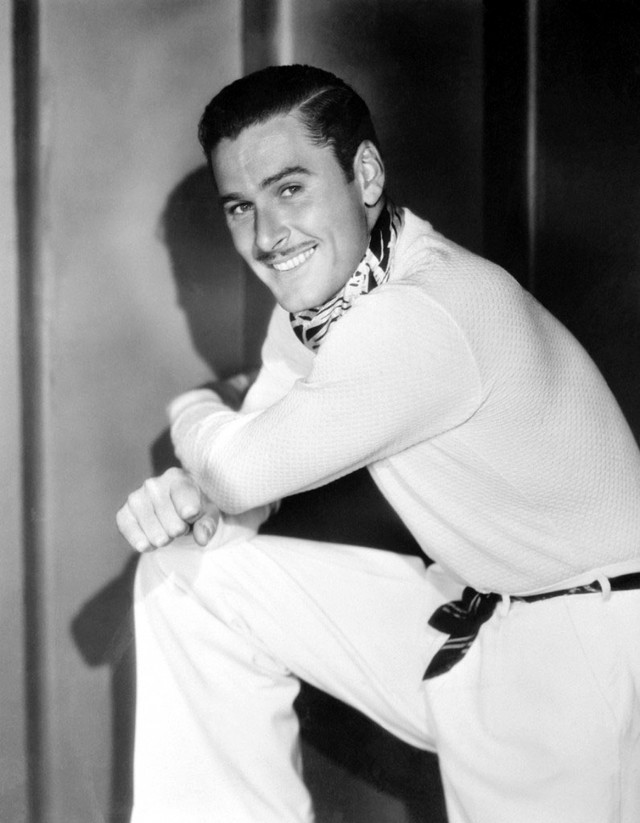
I mean look at that white sweater + white pants + moustache: This guy is just asking you to think skeevy thoughts about him. There were rumors of dalliances with Dietrich, Carole Lombard, Bette Davis, and Dolores Del Rio. The saying “In Like Flynn” entered the vernacular as shorthand for “gaining access/obtaining one’s goal,” a.k.a. “sealing the deal,” a.k.a. “getting into someone’s pants.”
This was also around the time, give or take a few years, that was recreated in Martin Scorsese’s The Aviator. And say what you will about how long that movie is, or how gross DiCaprio’s facial hair gets at the end, but the film is one of the great contemporary movies about classic Hollywood. The casting is perfect — Kate Beckinsale as Ava Gardner, Gwen Stefani as a blank Jean Harlow, Cate Blanchett embodying the spirit, if not the pointedness, of our lady Katharine, and Jude Law as the golden-hued Flynn himself.
The clip’s below, but make sure to watch for:
1. UM HELLO Adam Scott, nice moustache.
2. Flynn’s hilarious suggestion that Hepburn use “Lux” (the soap most stars promoted in the pages of the fan magazines) on her hands.
3. “You can’t have fornication in a Western, it isn’t done, old boy.”
4. Flynn is totally the type of totally rich dude who never has his own cigarettes (or pays for the cab, or buys his own coffee, etc. etc.).
5. “I’ve even managed to coax the luscious Ms. De Havilland and her equally luscious sister to accompany me — although I fear their mother would insist on coming along to preserve their … questionable virtue.” (Oh, did I neglect to mention that De Havilland’s sister was one Joan Fontaine?)
“I’m a TASMANIAN bastard, you idiot!”
It’s an impersonation, and a bit of a caricature, but most star images are, recall, caricatures of social types. As Flynn, Law brings out the most salient ingredients of the star’s persona: the debonair looks, the manipulation, the womanizing, the garrulousness, the slight repugnance, but the charm — it’s there in spades.
As the clip alludes, the supposed love of Flynn’s life was De Havilland, who apparently loved him as well — but realized straightaway what kind of relationship she was in for. They flirted, they were best friends, they spent all their time together, but girl was just too smart. It wasn’t that she was a prude, exactly — she’d had affairs with Jimmy Stewart and director John Huston — only neither were married. De Havilland just saw how dead-end a dalliance would be and, potentially, understood how much better their chemistry would be if their attraction remained unfulfilled.
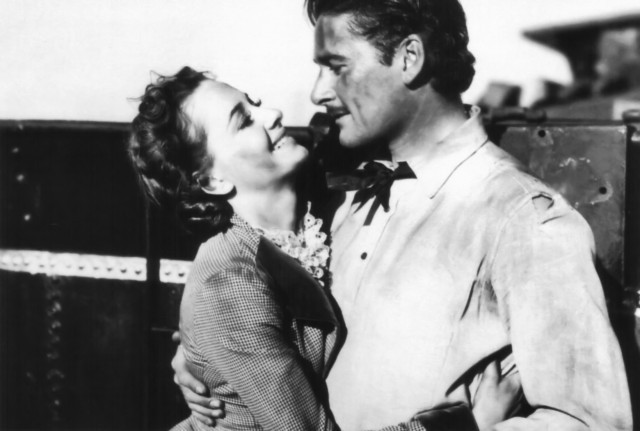
Plus, De Havilland had important things to do — like getting pissed at Warner Bros. and filing the suit that effectively ended the seven-year contract in Hollywood, thenceforth known as the “De Havilland Decision.” Lady was a boss. Flynn, however, was seemingly at odds with himself: a son, Sean, was born in May 1941. Happy young family, la-di-da. Gossip columnist Hedda Hopper reported that Flynn was spending the days after the birth making a “peacock run” on his property and boasting about his baby on-set. As Hopper fawned, “I must say, Errol has a divine disposition and looks every inch the movie-picture star,” which I’m assuming is shorthand for “looks hot with a pipe.”
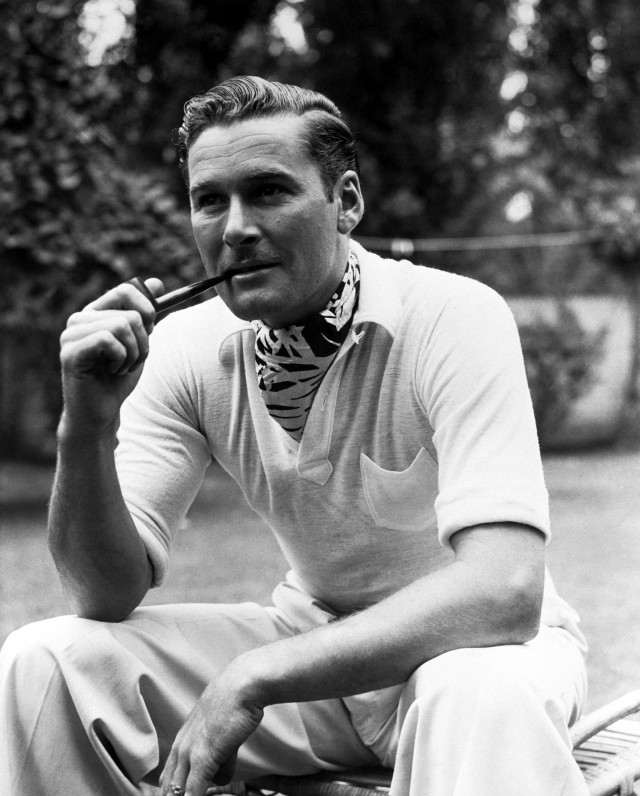
But on September 20th, Dimita filed for divorce, citing cruel and unusual punishment. As would emerge over the course of the divorce hearing, Flynn had taken to taking month-long trips by himself, and often left for days at a time to go sailing, even after the birth of his son.
And then things started getting crazy. Two days later, Flynn made front page news after confronting gossip columnist Jimmie Fidler at the Mocambo Cafe. As Flynn explained, “Fidler told one too many lies about the motion picture business … That’s why I went up to his table and told him what I thought about him. I put my left fist up against his chin and gave him a slap with my right hand on the side of the head. I said ‘You’re not worth a fist.’”
But then “his wife became angered and I tried to hold her to one side, still gripping Fidler, but finally she jabbed at me with a fork, which would have stuck me in the eye had I not turned my head. Instead it pierced my ear. I must say that I admire Mrs. Fidler, God bless her. She has the courage to try to defend her husband — much more courage than he himself has.”
For his part, Fidler claimed Flynn had come over to the table, ran his mouth, tried to punch him, lost his diamond cuff links in the process, accused Fidler of stealing said cufflinks, gone back to drinking, taken a lady to the dance floor, passed his seat on the way there, and up and tried to punch him again.
And when things were just about to get real, the band leader started into “The Star-Spangled Banner.” I couldn’t make this stuff up, kids. It reminds me of the glory days of LiLo, Brit-Brit, and Paris Hilton, when TMZ was first making its name recording rich drunk teens calling stars “firecrotch.” THOSE WERE THE DAYS.
Fidler filed battery charges, in part because Flynn was “going around saying that he’ll punch me every time he sees me.” Fidler didn’t want money — he wanted protection. His barb: “Remember that Flynn is a former Olympic boxing champion. He is 31, 6 feet 1 inch tall and weighs at least 185 pounds. I am 41, 5 feet 8 inches tall, and I weigh only 152 pounds.”
Flynn’s retort: “I slapped him. In Ireland that’s tantamount to the worst insult a man can give another man … I want to add, however, that [Mrs. Fidler] showed bad etiquette and used the wrong fork — she should have used the entree fork.”
Now, recall that Flynn was not, in fact, from Ireland. What’s more, these comments aren’t in the gossip column — they’re in the Los Angeles Times. The entree fork! I DIE! By October, Flynn was on the front page, shaking hands with the judge and promising not to punch anyone. And then what do we do with the fact that he was starring in Gentleman Jim, based on the life of champion Irish-American boxer James “Gentleman Jim” Corbett, due out THAT NOVEMBER? You sneaky Flynn!
However clever — or simply belligerent — Flynn may have been, it was the beginning of a downward spiral, characterized by copious amounts of alcohol, women, and brawling. By August 1942, Hopper was whispering quite loudly that “Errol Flynn’s at it again. He’s supposed to be sitting on his yacht in Balboa Bay, but he isn’t. He’s down in Mexico City for a few days. Who’s with him I’m not a-tellin’. But he’s escaping from ‘Edge of Darkness’ — hasn’t wanted to do it from the first. I must say the last time I saw him, he didn’t look well enough to do any picture.”
Then, like now, I guess it wasn’t okay to just say that a Hollywood star was on a total bender and hooking up with some girl in Mexico.
But then things got serious. In October, Flynn and two other men were arraigned in connection with the “mistreatment” of Betty Hansen, a 17-year-old would-be starlet from Nebraska. As her mother told the Times, “She was a little Christian girl, she must have had dope or something.”
Less than a week later, another 17-year-old, this time a nightclub “entertainer,” Peggy La Rue Satterlee, filed another assault complaint, which allegedly took place on the actor’s yacht the year before, when she was only 15. The parents had dropped the complaint as they came to understand the magnitude of the publicity, but the recent complaint encouraged them to come forward once again. Satterlee had been on the yacht before with her sister, but nothing had happened. Flynn called her, asked her on the yacht again, sans sister, picked up another girl, and Flynn, his stunt man, and a national magazine photographer spent the weekend at sea, during which Flynn allegedly assaulted Satterlee three times. And from what I can understand, “assault,” in this case, means “sexual assault.”
The articles from the papers are filled with details and vaguery: lots of tales of milk and rum and Flynn referring to one of the girls as “J.B.” (jailbait) and “S.Q.Q.” (San Quentin Quail). Descriptions of clothes, descriptions of accents, descriptions of what they can’t, legally, describe. Amidst it all, a 13-year-old boy tried to extort $10,000 from Flynn — threatening that he’d kill him if he didn’t. The defense did its best to shame Satterlee, revealing her “illegal procedure” after an “indiscretion with another man,” and making much to-do about her history of misrepresenting her age to gain employment and GET READY, YOU GUYS, hitch-hiking.
If you’ve watched Law & Order: SVU, you know how these things go. Crafty, expensive defense counsel undercuts accusations of sexualized, working-class girls. The jury found in favor of Flynn, with reports from the jury room claiming that “nine housewives” held a “private huddle” to convince the three hold-out votes, all men, to acquit, citing the girls’ repeated changes in testimony and evidence of their previous history with various men.
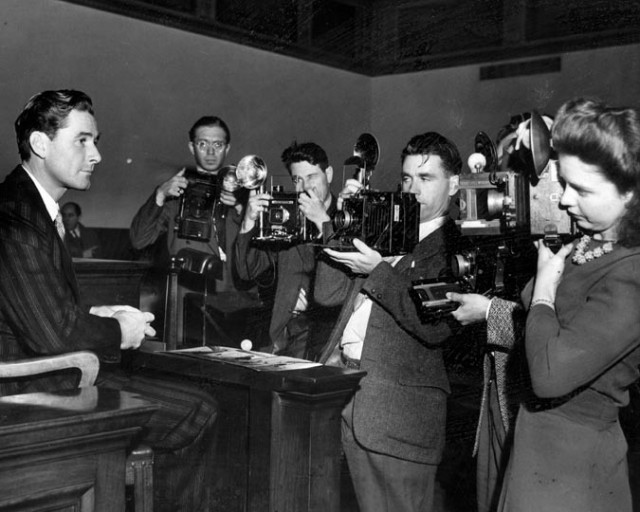
Two months later, Flynn’s next film — a pro-war fictionalization of the Norwegian resistance against the Nazi’s called Edge of Darkness — hit theaters. He was labeled 4-F and unable to enlist, so instead did his part by playing wartime heroes. Luckily for Fox, Flynn suffered from recurrent bouts of malaria from his youth, along with chronic back pain — “respectable” ailments that allowed the studio to ignore the alcoholism and accumulated venereal diseases that also kept him out of combat.
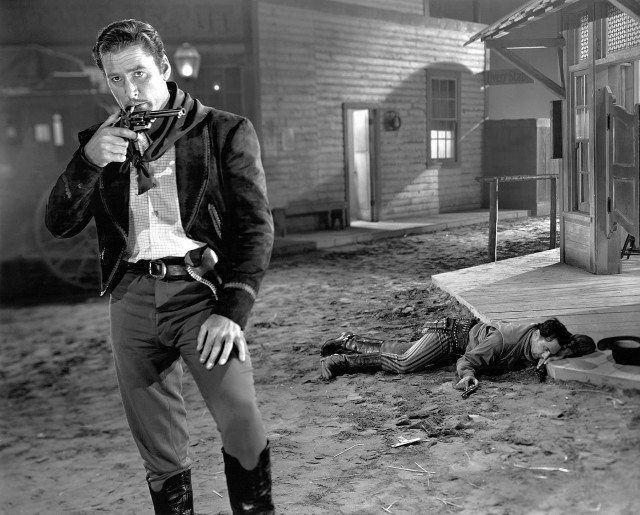
Land-swashbuckling in ‘San Antonio’ (1945).
Flynn was back in the gossip columns, back to work, and, by the beginning of 1944, back to marriage, this time to 20-year-old Nora Eddington, who had been working at the courthouse during Flynn’s trial. But Flynn’s career would never be the same. He became a caricature of his womanizing self: drunken, lecherous, and leering, even if somehow still handsome. He and Eddington had two children and evidently spent time hanging out with Rita Hayworth and Orsen Welles and looking tan and beautiful.
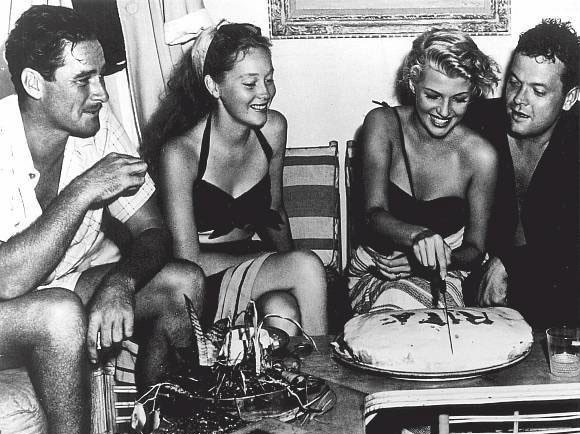
But the magic was all gone. The mystery and cunning that transforms handsome into sexy had seeped away, puddling on the floor of that courtroom. Eddington left Flynn in 1949 for her long-term lover, Dick Haynes — a true Hollywood asshat who would divorce her four years later for, guess who, Rita Hayworth.
Flynn was one of dozens of actors who found a second life on early television, only his second life was characterized by slurred speech and a bloated face. He suffered from hepatitis and liver failure. As Mike Campbell in The Sun Also Rises (1957), he was essentially playing a version of himself. When he died in October 1959, at age 50, the official cause was heart failure, but it could’ve easily have been his distended colon, shredded liver, or crippling depression.
It’s difficult to know what to say. We can’t know what exactly happened on the yacht, or in the backroom of a private party, but we can know that Flynn was used to getting what he wanted, and most of society was ready to shame the girl who “gave it over” instead of the man who took it.
I don’t want to excuse Flynn or exonerate him. I don’t want to shame those girls who, in all likelihood, were taken advantage of. But I do want to underline that while Flynn was a womanizer, he was by no means the only one behaving in this way — whether it was then, in the ’70s, or today. Reading the excuses that his female fans made for him, the way the female jurors talked about his accusers, the way this portion of his story has been brushed aside in favor of his younger, less flagrant self — all of it reeks of male privilege and, more damningly, female complicity with that very system of oppression.
Stars and what we expect and forgive of them are always products of their time. Their images reflect ourselves and what we value. I love to revel in classic Hollywood: in the clothes, the hats, the fast-talking and the slow burn. But every so often a star’s image, whether it’s Flynn’s, Dorothy Dandridge’s, or Rita Hayworth’s, reminds me of how far we have and have not come. Who is the Flynn of our time?
You, Me, and Everyone We Know knows the answer to that question. So what questions will our grandchildren ask about the public behavior we tolerated and implicitly endorsed? And what will be our confused, equivocating, angry answers?
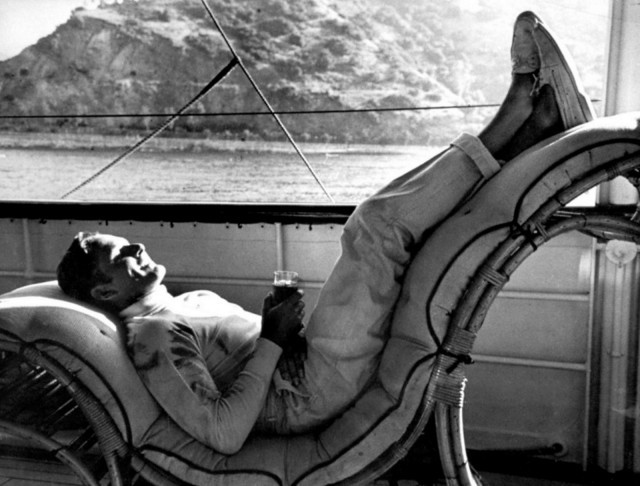
Previously: The Most Wicked Face of Theda Bara
Anne Helen Petersen is a Doctor of Celebrity Gossip. No, really. You can find evidence (and other writings) here.